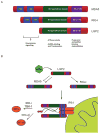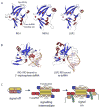Sensing of viral nucleic acids by RIG-I: from translocation to translation
- PMID: 21496944
- PMCID: PMC3155743
- DOI: 10.1016/j.ejcb.2011.01.015
Sensing of viral nucleic acids by RIG-I: from translocation to translation
Abstract
The innate immune system is a first layer of defense against infection by pathogens. It responds to pathogens by activating host defense mechanisms via interferon and inflammatory cytokine expression. Pathogen associated molecular patterns (PAMPs) are sensed by specific pattern recognition receptors. Among those, the ATP dependent helicase related RIG-I like receptors RIG-I, MDA5 and LGP2 sense the presence of viral RNA in the cytoplasm of host cells. While the precise PAMPs and functions of MDA5 or LGP2 are still unclear, RIG-I senses predominantly viral RNA containing a 5'-triphosphate along with dsRNA regions. Here we review our current knowledge of how these PAMPs are sensed and integrated by RIG-I, and how RIG-I's innate immune function can be used in translational medical approaches.
Copyright © 2011 Elsevier GmbH. All rights reserved.
Figures



Similar articles
-
Regulation of RLR-mediated innate immune signaling--it is all about keeping the balance.Eur J Cell Biol. 2012 Jan;91(1):36-47. doi: 10.1016/j.ejcb.2011.01.011. Epub 2011 Apr 9. Eur J Cell Biol. 2012. PMID: 21481967 Review.
-
Spatiotemporal dynamics of innate immune signaling via RIG-I-like receptors.Proc Natl Acad Sci U S A. 2020 Jul 7;117(27):15778-15788. doi: 10.1073/pnas.1921861117. Epub 2020 Jun 22. Proc Natl Acad Sci U S A. 2020. PMID: 32571931 Free PMC article.
-
From virus to inflammation: mechanisms of RIG-I-induced IL-1β production.Eur J Cell Biol. 2012 Jan;91(1):59-64. doi: 10.1016/j.ejcb.2011.01.013. Epub 2011 Apr 9. Eur J Cell Biol. 2012. PMID: 21481488 Review.
-
Proofreading mechanisms of the innate immune receptor RIG-I: distinguishing self and viral RNA.Biochem Soc Trans. 2024 Jun 26;52(3):1131-1148. doi: 10.1042/BST20230724. Biochem Soc Trans. 2024. PMID: 38884803 Free PMC article. Review.
-
ATP-dependent effector-like functions of RIG-I-like receptors.Mol Cell. 2015 May 7;58(3):541-548. doi: 10.1016/j.molcel.2015.03.014. Epub 2015 Apr 16. Mol Cell. 2015. PMID: 25891073 Free PMC article.
Cited by
-
ATP hydrolysis enhances RNA recognition and antiviral signal transduction by the innate immune sensor, laboratory of genetics and physiology 2 (LGP2).J Biol Chem. 2013 Jan 11;288(2):938-46. doi: 10.1074/jbc.M112.424416. Epub 2012 Nov 26. J Biol Chem. 2013. PMID: 23184951 Free PMC article.
-
The battle between rotavirus and its host for control of the interferon signaling pathway.PLoS Pathog. 2013 Jan;9(1):e1003064. doi: 10.1371/journal.ppat.1003064. Epub 2013 Jan 24. PLoS Pathog. 2013. PMID: 23359266 Free PMC article. Review.
-
RIG-I-like helicases induce immunogenic cell death of pancreatic cancer cells and sensitize tumors toward killing by CD8(+) T cells.Cell Death Differ. 2014 Dec;21(12):1825-37. doi: 10.1038/cdd.2014.96. Epub 2014 Jul 11. Cell Death Differ. 2014. PMID: 25012502 Free PMC article.
-
DEAD-Box Helicase DDX25 Is a Negative Regulator of Type I Interferon Pathway and Facilitates RNA Virus Infection.Front Cell Infect Microbiol. 2017 Aug 4;7:356. doi: 10.3389/fcimb.2017.00356. eCollection 2017. Front Cell Infect Microbiol. 2017. PMID: 28824886 Free PMC article.
-
Positive evolutionary selection on the RIG-I-like receptor genes in mammals.PLoS One. 2013 Nov 27;8(11):e81864. doi: 10.1371/journal.pone.0081864. eCollection 2013. PLoS One. 2013. PMID: 24312370 Free PMC article.
References
-
- Akira S, Uematsu S, Takeuchi O. Pathogen recognition and innate immunity. Cell. 2006;124:783–801. - PubMed
Publication types
MeSH terms
Substances
Grants and funding
LinkOut - more resources
Full Text Sources
Other Literature Sources
Medical
Molecular Biology Databases

